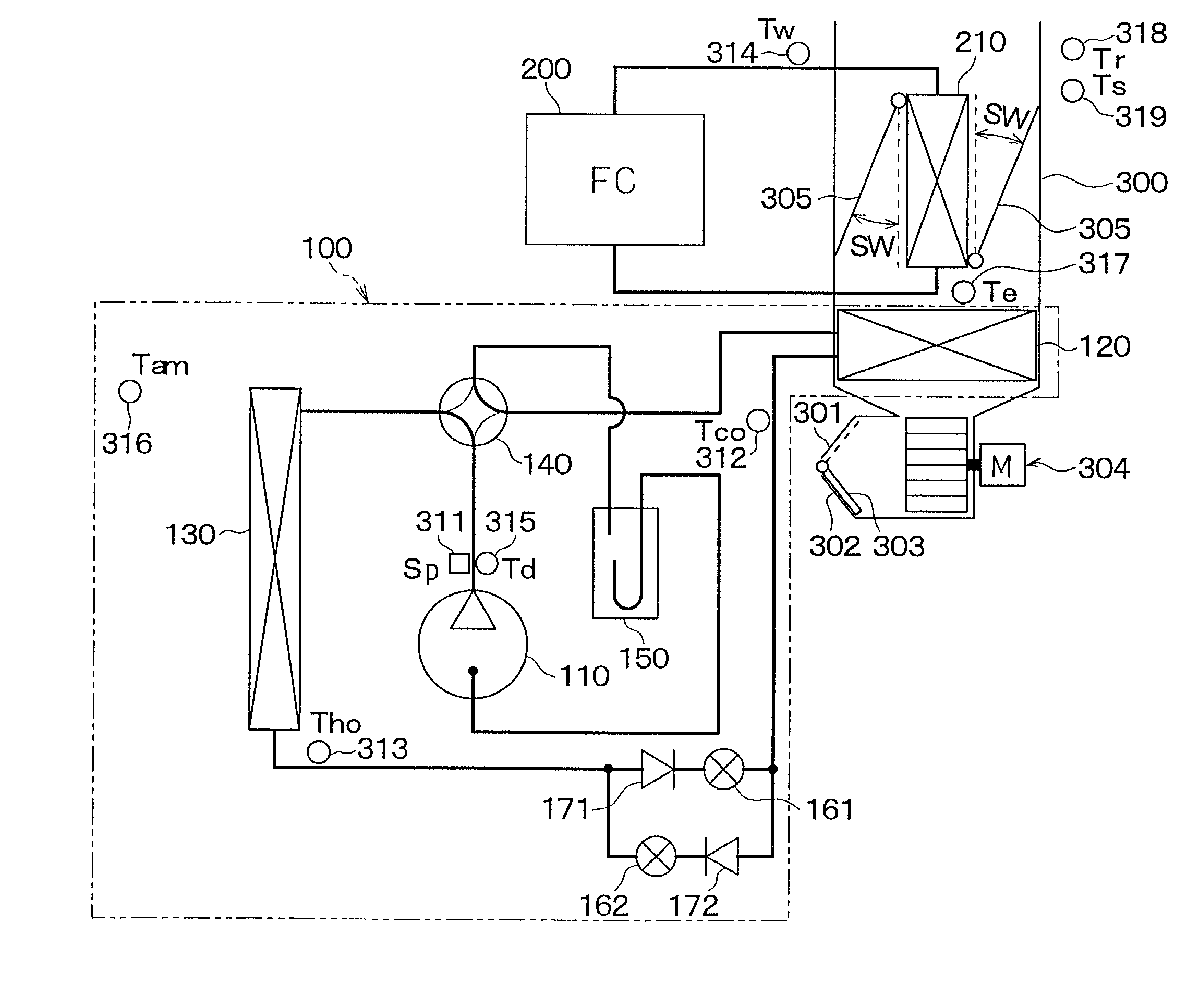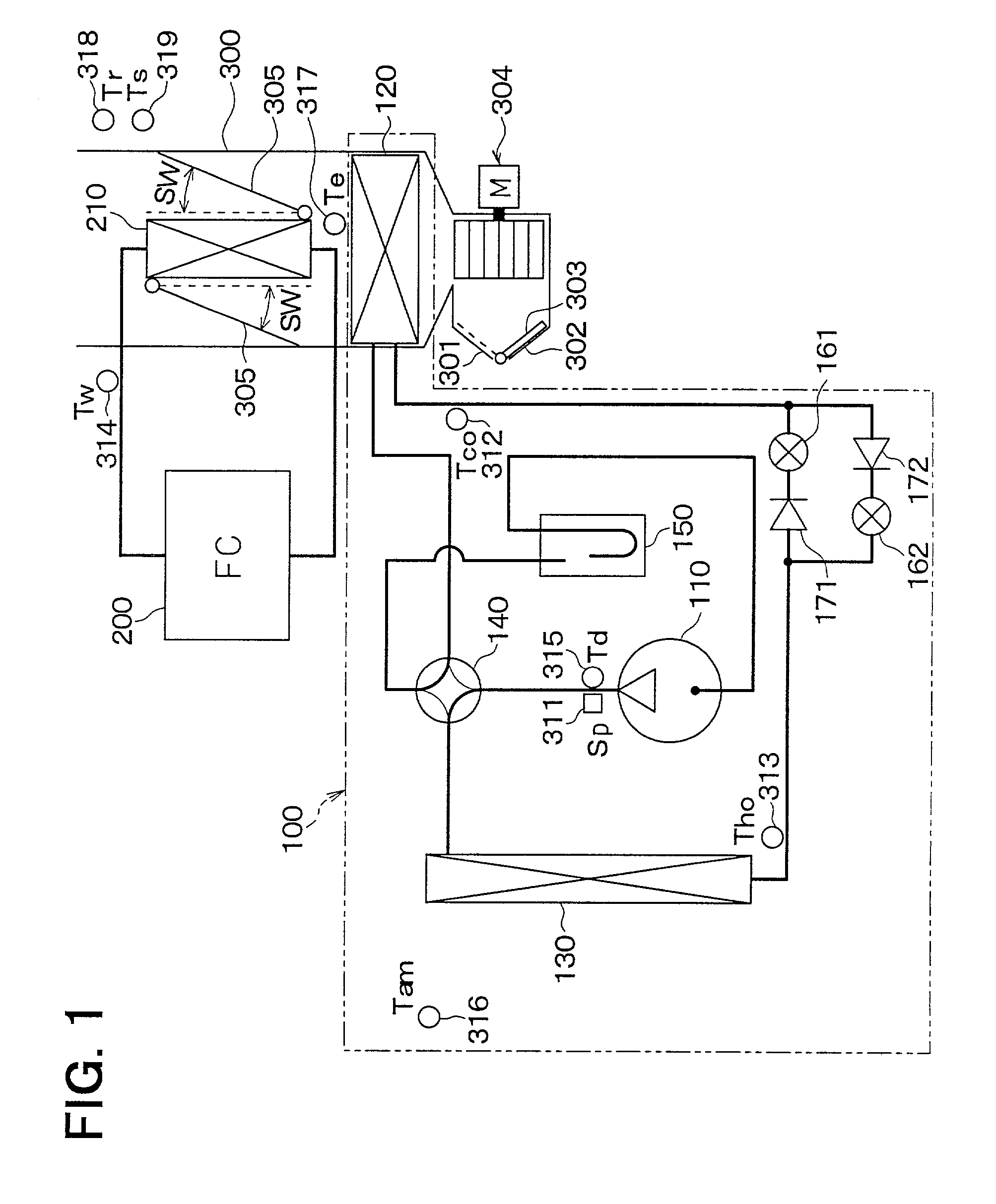Vehicle air conditioner with defrosting operation of exterior heat exchanger
a technology of heat exchanger and vehicle, which is applied in the direction of defrosting, heating apparatus, domestic cooling apparatus, etc., can solve the problems of increased consumption power of heat pump cycle (compressor), deterioration of heat-absorbing efficiency of exterior heat exchanger, and inability to perform heating operation
- Summary
- Abstract
- Description
- Claims
- Application Information
AI Technical Summary
Benefits of technology
Problems solved by technology
Method used
Image
Examples
first embodiment
[0030] (First Embodiment)
[0031] In the first embodiment, a vehicle air conditioner according to the present invention is typically used for an electric vehicle having a fuel cell (FC stack) as a power supply. The first embodiment will be now described with reference to FIGS. 1-5.
[0032] In FIG. 1, a heat pump cycle (heat pump) 100 enclosed by a two-dot chain line is disposed to switch an operation mode between a heating operation, a cooling operation and a defrosting operation, and a fuel cell (macromolecule-electrolyte type fuel cell) 200 is disposed to generate electric power by a chemical reaction between oxygen and hydrogen.
[0033] A compressor 110 (electric compressor) sucks and compresses refrigerant using an inverter control. An interior heat exchanger 120 is disposed to perform a heat exchange between refrigerant and air blown into a passenger compartment, and an exterior heat exchanger 130 is disposed to perform a heat exchange between refrigerant and outside air.
[0034] A fou...
second embodiment
[0069] (Second Embodiment)
[0070] In the second embodiment, when frosting on the surface of the exterior heat exchanger 130 is determined, when the temperature of hot water supplied to the heater core 210 is equal to or higher than the predetermined temperature and when a vehicle speed Vs is equal to or higher than a predetermined speed Vso (e.g., 11 km / hour, in the second embodiment), the defrosting operation is performed.
[0071] Accordingly, frost is melted by the defrosting operation, and the melted water drops can be blown away by vehicle travelling wind. Therefore, when the heating operation is performed again after finishing the defrosting operation, water drops (frost) melted in the defrosting operation can be prevented from being freezed again, thereby lengthening a heating operation time.
[0072] Next, operation of a vehicle air conditioner according to the second embodiment will be described with reference to the flow diagram in FIG. 6.
[0073] When the heating operation switch ...
third embodiment
[0081] (Third Embodiment)
[0082] When the vehicle speed is excessively high in defrosting operation, the exterior heat exchanger 130 is greatly cooled by vehicle travelling wind. Therefore, defrosting operation efficiency may be decreased, and power consumed in the compressor 110 for melting frost may be increased.
[0083] In the third embodiment, when the frosting on the surface of the exterior heat exchanger 130 is determined, when the temperature of hot water supplied to the heater core 210 is equal to or higher than the predetermined temperature, and when the vehicle speed Vs is higher than a first predetermined speed Vs1 (e.g., 10 km / hour in the third embodiment) and is lower than a second predetermined speed Vs2 (e.g., 40 km / hour in the third embodiment), the defrosting operation is performed.
[0084] Next, operation of a vehicle air conditioner according to the third embodiment will be described with reference to the flow diagram in FIG. 7.
[0085] When the heating operation switch ...
PUM
 Login to View More
Login to View More Abstract
Description
Claims
Application Information
 Login to View More
Login to View More - R&D
- Intellectual Property
- Life Sciences
- Materials
- Tech Scout
- Unparalleled Data Quality
- Higher Quality Content
- 60% Fewer Hallucinations
Browse by: Latest US Patents, China's latest patents, Technical Efficacy Thesaurus, Application Domain, Technology Topic, Popular Technical Reports.
© 2025 PatSnap. All rights reserved.Legal|Privacy policy|Modern Slavery Act Transparency Statement|Sitemap|About US| Contact US: help@patsnap.com



